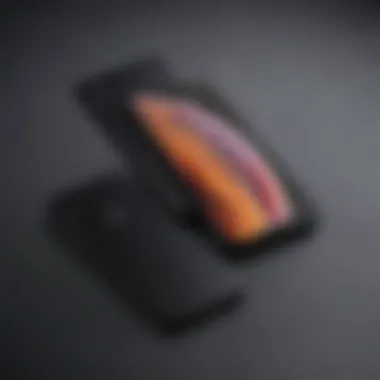Detailed Comparison of iPhone XR vs iPhone X Models


Product Overview
In the bustling world of smartphones, the Apple iPhone XR and iPhone X stand out as two pivotal models that Apple released in the quest for innovation and user satisfaction. The iPhone XR made its debut in October 2018, boasting a lively array of colors and a sleek design, while the iPhone X, launched a year earlier, represented a significant leap forward with its edge-to-edge display and premium build quality.
Key Features and Specifications
Both devices come packed with impressive specifications, catering to different types of users:
- iPhone XR: 6.1-inch Liquid Retina display, A12 Bionic chip, 12MP rear camera with Smart HDR, available in six vivid colors (Black, White, Blue, Yellow, Coral, Product(RED)), and a battery life that stretches up to 25 hours of talk time.
- iPhone X: 5.8-inch Super Retina display, A11 Bionic chip, 12MP dual rear cameras (wide-angle and telephoto), available in Space Gray and Silver, and a battery that lasts around 21 hours of talk time.
These highlights set the stage for a deeper exploration into their design, performance, and overall user experience.
Design and Build Quality
Visual Description
The visual aesthetic of both the iPhone XR and iPhone X presents a study in contrasts. The iPhone XR's bright colors lend a youthful and playful vibe, while the iPhone X exudes a more refined, luxurious presence. The XR features an aluminum and glass construction that is sturdy yet lightweight. On the other hand, the X utilizes surgical-grade stainless steel, providing both elegance and robustness.
Materials and Ergonomics
Material selection plays a crucial role here. The iPhone XR, with its durable glass back, allows for wireless charging, but its aluminum frame does not quite match the premium feel of the iPhone X’s stainless steel. Handling either phone feels comfortable in the hand, but the slightly larger display of the XR can make one-handed usage a bit tricky, especially when reaching for items in the upper corners of the screen.
Performance and User Experience
Processor Details
Diving into performance, both models showcase prowess that reflects Apple’s focus on speed and efficiency. The iPhone XR is powered by the A12 Bionic chip, allowing for seamless performance during multitasking and gaming. In contrast, the iPhone X employs the older A11 Bionic chip but still holds its ground for most tasks, thanks to optimized software.
User Interface Features
The user experience on both models is enriched by iOS, which continues to evolve. Users appreciate the smooth interface, enhanced gestures, and an array of functionalities that come with each hardware.
Camera and Media Capabilities
Specifications and Media
In terms of photography, the iPhone X takes a small edge with its dual-camera setup, which offers better versatility, particularly in low-light situations. The iPhone XR's single 12MP camera still produces stunning images, thanks to its Smart HDR feature. Users find that both phones excel in video capture, supporting 4K recording at various frame rates.
"The camera remains a decisive factor for many consumers, and the impression of quality in snapshots can dramatically influence purchasing habits in a saturated market."
Pricing and Availability
Pricing Options
When it comes to pricing, the iPhone XR typically comes at a more accessible price point than the iPhone X, which positions it as a more budget-friendly option for consumers without sacrificing too much on performance. Both models remain in demand, with varying availability based on the region.
Comparison with Competitors
While looking to competitors like Samsung Galaxy S9 and Google Pixel 2, both Apple models maintain a respectable place in the smartphone hierarchy, particularly influencing customers seeking reliability and brand loyalty.
Understanding these distinctions helps buyers make informed decisions, ensuring they choose the model that best aligns with their needs and lifestyle.
Intro to iPhone Models
The study of iPhone models not only serves as an insight into Apple's technological artistry but also reflects the evolving landscape of smartphone innovation. Diving into the comparative analysis of the iPhone XR and iPhone X brings forward the decisions consumers must face in a rapidly changing market. The significance of this analysis lies in its ability to unravel the complexities that accompany these flagship models. Each iteration carries unique elements that resonate differently with varied user demographics, making it crucial for potential buyers to understand what sets them apart.
Understanding the differences between the iPhone XR and iPhone X helps illuminate how Apple tailors its offerings. Not all users demand the top-tier specifications that may come with a hefty price tag. For many, a balance of features, performance, and budget emerges as a foremost concern. Thus, being informed about these models can ease the purchasing decision, empowering users to align their preferences with suitable options.
Historical Context
Apple introduced the iPhone XR in 2018, positioning it as a more affordable alternative to its flagship iPhone X, which hit the market a year earlier. The advent of the iPhone X marked Apple's tenth anniversary in the smartphone arena, setting a high bar with its edge-to-edge OLED display and innovative Face ID technology. The iPhone XR aimed to attract a broader audience by incorporating elements from its predecessor while trimming down on the price, effectively redefining what consumers might expect from a mid-range smartphone offering. This shift in pricing and features highlights Apple's strategy to penetrate diverse segments of the market, democratizing access to its premium technology.
As the smartphone landscape has evolved, so have user expectations. Where the iPhone X showcased pioneering technology, such as the A11 Bionic chip and dual camera capabilities, the iPhone XR sought to deliver similar experiences through slight sacrifices. Observing these historical developments gives users a clearer view of how Apple has navigated consumer demands while still reinforcing brand loyalty.
Positioning within Apple's Lineup
In Apple's lineup, each model is a strategic move aimed at addressing specific consumer needs and market segments. The iPhone X positioned itself as a luxury device, appealing to enthusiasts who seek the latest and greatest in mobile technology. In contrast, the iPhone XR aimed to bridge the gap, offering many of the features found in high-end devices but at a friendlier price point.
Examples of how the two models differ include:
- Display Technology: iPhone X boasts an OLED display, while iPhone XR utilizes an LCD variant.
- Camera Specifications: Dual-camera system in iPhone X vs. a single lens in iPhone XR, appealing to casual photographers.
- Color Variants: iPhone XR's vibrant color options reflect a playful character, targeting a younger demographic.
This nuanced positioning helps buyers navigate their preferences. While brand loyalists may gravitate toward the premium feel of the iPhone X, budget-conscious users or those entering the Apple ecosystem may find the iPhone XR perfectly matched to their needs. Ultimately, the choice boils down to individual priorities regarding performance, aesthetics, and cost.
Design and Build Quality
The design and build quality of smartphones play a significant role in not just the aesthetic appeal, but also in their durability and overall user satisfaction. With regards to the iPhone XR and iPhone X, both models showcase Apple's commitment to premium craftsmanship but exhibit their own unique characteristics. This section will delve into the physical dimensions, material choices, and color options that define these iconic devices, highlighting why these elements are crucial considerations for potential buyers.
Physical Dimensions
When it comes to physical dimensions, there’s more than meets the eye. The iPhone X measures 143.6 x 70.9 x 7.7 mm and weighs 174 grams, while the iPhone XR is slightly bigger at 150.9 x 75.7 x 8.3 mm, tipping the scales at 194 grams. This difference in size and weight can influence how the devices feel in hand. The XR offers a larger screen, which can enhance viewing experiences, especially for videos and gaming, but it may feel bulkier for those with smaller hands.
- iPhone X: 5.8-inch display, compact and lightweight.
- iPhone XR: 6.1-inch display, larger but heftier.


This can matter in fast-paced settings where quick accessibility is key. Your choice will depend on personal comfort and how you use your device.
Material Choices
Material choices are vital as they not only contribute to the aesthetic but also impact durability. The iPhone X is crafted from surgical-grade stainless steel paired with glass on both front and back, exuding a luxurious feel. This steel frame provides robustness but adds some weight to the device.
On the other hand, the iPhone XR utilizes an aluminum frame alongside a glass back. While aluminum is lightweight and adds to the phone's portability, some purists may argue it lacks the premium feel of stainless steel. The glass on both models has a certain appeal, inviting the eye with its sleek, reflective surface. Both options include durable materials that resist fingerprints, yet the overall feel and vibe differ markedly.
Color Options
Color options often dictate a user’s initial attraction to a device. The iPhone X presents a classic choice with its silver and space gray variations, appealing to those who prefer timeless elegance. These colorways complement the sophisticated stainless steel frame, creating a streamlined look.
Conversely, the iPhone XR bursts onto the scene with a burst of colors; featuring options like coral, blue, yellow, black, and (PRODUCT)RED. This spectrum of choices allows users to express individuality, catering to a younger or more playful demographic.
- iPhone X:
- iPhone XR:
- Silver
- Space Gray
- Coral
- Blue
- Yellow
- Black
- (PRODUCT)RED
In summary, the color choices not only reflect personal style but can also sway your decision based on the context in which the phone will be used. The ability to match or contrast with accessories adds another layer of personalization.
"Design speaks where words are unable to explain. What speaks to you can dictate your next phone purchase."
Incorporating these various elements helps users understand not only what each phone offers, but how those options align with their preferences and lifestyle. Whether you lean towards the elegant sheen of the iPhone X or the playful palette of the iPhone XR, design and build quality set the stage for overall user experience.
Display Technology
The display technology of smartphones serves as a crucial element, acting as the window through which users interact with their devices. When comparing the iPhone XR and iPhone X, understanding the intricacies of their displays helps dictate not only visual quality but also user experience, energy consumption, and overall usability. These aspects weigh heavily on consumer preferences and can often sway decisions between models.
Screen Size and Resolution
The iPhone XR features a 6.1-inch Liquid Retina display, while the iPhone X boasts a 5.8-inch Super Retina display. This difference in size might seem merely cosmetic, but it significantly impacts usability.
- User Experience: The larger screen of the XR appeals to those who enjoy multimedia content, such as videos and games, presenting brighter, more vibrant visuals. In contrast, the X’s slightly smaller screen fits comfortably in the hand, ideal for one-handed use in everyday scenarios.
- Resolution: The iPhone X's resolution is sharper at 1125 x 2436 pixels compared to the XR's 828 x 1792 pixels. The pixel density in the X is greater, translating into crisper images and sharper text, essential for reading and detailed graphics.
This divergence allows users to choose based on their viewing preferences and needs—whether one prioritizes display real estate or high-definition clarity.
Display Type: vs OLED
Apple has utilized different display technologies in these models, which are pivotal for potential buyers to assess. The iPhone XR employs Liquid Retina LCD, while the iPhone X incorporates Super Retina OLED.
- Vibrancy and Contrast: OLED displays are well noted for their deep blacks and high contrast ratios. This means in darker settings, the iPhone X can deliver more striking and defined imagery than the XR. On the flip side, LCDs tend to fare competently in brightly lit environments and maintain color accuracy without excessive power drain.
- Longevity and Burn-In: Users concerned with screen longevity should note that LCD technology typically presents a lower risk for burn-in issues that OLED screens may encounter over time. This could be a deciding factor for consumers who plan on keeping their devices for several years without a change.
Brightness and Color Accuracy
Brightness and color accuracy are paramount in defining a quality display. The iPhone XR peaks at 625 nits, while the iPhone X can reach up to 1200 nits in HDR content. This capability means the iPhone X excels in vivid environments, ensuring content remains visible regardless of external lighting.
- Natural Color Reproduction: The two devices approach color accuracy differently, primarily due to their display technologies. The iPhone X's OLED panel is capable of producing a broader color gamut and deeper colors. Users aiming for true-to-life colors will find the X's display superior.
- Adaptive Brightness: Both devices feature adaptive brightness settings, but the iPhone X tends to deliver a more refined experience. This is particularly useful in varying lighting conditions, adjusting seamlessly to provide optimal visual clarity.
Ultimately, the differences in display technology between the iPhone XR and iPhone X allow consumers to weigh their priorities—whether they favor screen size, resolution, or overall display type. As these specifications directly affect how users interact with their device, they are paramount for anyone looking to make an informed purchase.
Performance Comparison
The performance comparison of the iPhone XR and iPhone X is not just about numbers or specs; it provides insight into how these devices handle everyday tasks and demanding applications. For users, understanding performance means evaluating longevity, speed, and user experience. Each model's chip and storage options influence how smoothly it operates under duress, which can make or break user satisfaction. This is crucial as Apple enthusiasts often demand phones that can keep up with their busy lifestyles and multitasking needs.
Processor and Chip Performance
At the heart of the iPhone XR and iPhone X are their respective processors, which play a significant role in determining overall responsiveness and capability. The iPhone X came equipped with the A11 Bionic chip, a notable powerhouse at its time, offering excellent performance. It made tasks like gaming and augmented reality experiences feel seamless. On the other hand, the iPhone XR boasts the newer A12 Bionic chip, which leads to a noticeable performance boost.
The A12 chip is engineered to enhance efficiency with its 7-nanometer technology. Users have noted that even when running challenging applications or multiple tasks, the XR remains responsive and smooth. Notably, this chip also affords improved graphics capabilities, beneficial for mobile gamers or those who use graphically intense applications.
RAM and Storage Options
When diving into RAM and storage, the differences between the models also come into play. The iPhone X is equipped with 3GB of RAM, which, while adequate for most standard tasks, can be limiting when several apps are demanding attention. In contrast, the iPhone XR raises the bar with 3GB like its predecessor but pairs this with a more efficient A12 chip. This efficiency translates to better multitasking without the dreaded lag that can crop up in mobile settings.
Storage options further distinguish these models. The iPhone X starts at 64GB and goes up to 256GB, satisfying users with moderate storage needs. However, the iPhone XR's range of 64GB, 128GB, and 256GB provides a bit of flexibility, catering to various preferences. Users who prefer more room for apps, photos, and videos might find the XR's offerings more appealing.
The performance difference often becomes evident during heavy use cases, pushing both models to their limits. The iPhone XR’s A12 chip, combined with its efficient RAM usage, frequently ends up on top where responsiveness is critical.
Camera Capabilities
When diving into the myriad of features offered by smartphones today, camera capabilities often steal the spotlight. This is especially true for the iPhone XR and iPhone X, as they represent different philosophies in mobile photography, yet share the common goal of capturing life's moments in the best light possible. For Apple enthusiasts and tech lovers alike, understanding the nuances of each model's camera system is crucial when deciding which device meets their needs.
Rear Camera Specifications
Starting with the rear camera, the iPhone X features a dual-camera system comprising a 12-megapixel wide-angle and a 12-megapixel telephoto lens. This combination enables optical zoom that can deliver better photos in varied conditions. On the other hand, the iPhone XR, with its single 12-megapixel wide sensor, offers a strong performance but lacks the telephoto option. The characteristics of these cameras create a fundamental difference in how users experience photography.
- iPhone X:
- iPhone XR:
- Dual 12MP lenses (wide and telephoto)
- Optical image stabilization on both lenses
- Ability to achieve 2x optical zoom
- Single 12MP wide lens
- Smart HDR capabilities enhance dynamic range
- Lacks optical zoom but delivers solid performance overall


This choice boils down to a photographer's style. For those who enjoy variable focal lengths and refined details, the iPhone X may be the preferred option.
Front Camera Features
Shifting to the front-facing camera, both models sport a 7-megapixel TrueDepth camera system. However, the iPhone X adds a layer of sophistication with features like Portrait mode and Portrait Lighting, enhancing selfies with depth-of-field effects and striking light adjustments. The iPhone XR, while also capable of these effects, is more focused on integrating AR functionalities.
- Both Models:
- iPhone X:
- iPhone XR:
- 7MP TrueDepth camera with f/2.2 aperture
- Portrait mode capabilities
- Enhanced lighting options for selfies
- Better low-light performance due to dual-camera
- Integrates filters and Animoji in fun ways
- Focus on AR experiences
Ultimately, the intended use of the front camera often determines which device will better suit an individual’s needs.
Photo and Video Quality
When assessing photo and video quality, many factors come into play — sensor capabilities, processing power, and software enhancements. The iPhone X delivers superior versatility with its dual-lens setup, particularly in low-light situations, due to its optical zoom and larger sensor. Users can expect clearer images and smooth videos at 4K resolution, up to 60 fps. In contrast, the iPhone XR boasts computational photography advancements like Smart HDR, providing impressive results, especially in bright environments.
"The difference in photo quality between the two models can be seen not just in pixel counts, but in how each phone processes light and detail during image capture."
Both phones record video at 4K resolution, showcasing fluid motion and rich color depth. However, the real distinction lies in how each device balances this with other features:
- iPhone X features offer:
- iPhone XR provides:
- 4K recording at 24 fps, 30 fps, or 60 fps
- Slow-motion video support at 1080p
- 4K video support with Smart HDR
- Enhanced low-light performance in video using software tweaks
Battery Life and Charging
Battery life and charging capabilities are vital considerations when comparing the iPhone XR and iPhone X. In an era where smartphones serve as our primary tools for communication, navigation, and entertainment, a robust battery life can significantly enhance the user experience. This section delves into how both models fare in terms of battery capacity and the technologies available for charging.
Battery Capacity Analysis
When assessing the battery capacity in iPhone devices, numbers tell only part of the story. The iPhone XR comes equipped with a 2,942 mAh battery, which is larger than the iPhone X's 2,716 mAh battery. At initial glance, one might surmise that the XR simply outperforms its predecessor, an assumption that carries some weight. However, this isn't the entire picture.
The key lays in the efficiency of the A12 Bionic chip found in the XR compared to the A11 Bionic chip in the X. The newer chip’s manufacturing process allows for better performance without a significant drain on resources. After conducting several endurance tests, users have noted that the XR may provide up to 1.5 hours more usage compared to the X. It's an interesting juxtaposition—more power on paper yet yielding tangible results in practice.
Furthermore, aspects such as screen-on time and background activity management can impact actual performance. Users frequently comment on how the XR provides a more prolonged experience for day-to-day activities like streaming or gaming. All of this suggests that while the numbers indicate a straightforward comparison, the real-life experience can shift based on underlying technology and user behavior.
Charging Technologies
Charging technologies have advanced remarkably over the years, and both iPhone XR and iPhone X are included in this wave of innovation. Apple has developed multiple charging methods that enhance consumer convenience.
For starters, both models support wireless charging via Qi technology, which means you can simply place the phone on a compatible charging pad. Although wireless charging may not be as fast, it adds a layer of ease for users looking to charge their devices on the go without fussing with cables.
Additionally, both models also support fast charging, with a 18-watt adapter available separately. According to sources, these technologies can lead to getting a decent charge—up to 50%—in about 30 minutes. Here are some points to consider about their charging capabilities:
- Wired Charging: Using a Lightning cable, both phones can harness a quick charge effectively.
- USB-C Compatibility: The newer USB-C power adapters provide a better charging experience over previous USB-A chargers.
- Charging Times: Although both devices can utilize fast charging, user feedback indicates minor variances in real-time performance based on battery health and wear.
"Look under the hood, and you might find that charging isn’t just about speed; it's also about the smoothness of experience in daily usage."
In summation, while both battery life and charging technologies have evolved, they serve different roles in the overall user experience. Consumers interested in these aspects often cite performance and longevity as key drivers in making their smartphones last through busy days. It's essential to consider not just the specifications but also how both devices perform under practical usage scenarios, ultimately steering purchase decisions in the landscape of Apple’s offerings.
Software Experience
When considering any smartphone, the software experience plays a crucial role in how users interact with the device. In the case of the iPhone XR and iPhone X, Apple's iOS serves as the backbone around which various features and functionalities are built. Both models run on iOS, yet the nuances between their software capabilities can sway a consumer's choice.
Operating System Features
Both the iPhone XR and iPhone X come loaded with iOS, offering a host of features designed to enhance user functionality and experience. Let's explore some notable highlights:
- Regular Updates: Apple is known for providing updates consistently across its devices. Both the XR and X benefit from this, allowing users to enjoy new features and security enhancements.
- Enhanced Security: iOS bolsters security with features like Face ID and app sandboxing. While the iPhone X sports Face ID as a first-generation implementation, the XR utilizes the same technology, maintaining strong security across both devices.
- App Ecosystem: Both devices can access a diverse range of applications found in the App Store. Given their similar chipsets and processing capacities, performance in app usage is generally neck-and-neck.
However, the iPhone XR—being newer—may have optimizations for some more recent apps, giving it a slight edge in smoothly running the latest software developments. This can be an essential deciding factor for users who rely on the newest applications or features.
User Interface Differences
While both models utilize the same operating system, the user interface can feel subtly different due to the display technology. Here’s what you need to note about their interfaces:
- Display Characteristics: The iPhone X features an OLED display that produces deeper blacks and more vibrant colors compared to the LCD screen on the iPhone XR. This difference can make a noticeable impact on how certain user interface elements are presented. For example, darker themes in apps may appear richer on the iPhone X.
- Gestures and Navigation: Both devices benefit from iOS gestures for navigation, but the experience may slightly vary due to screen size. The XR’s larger screen can make some actions feel more intuitive, especially when multitasking on split apps.
- Adaptation to New Features: With continuous iOS updates, both models generally adapt to new features seamlessly. On the other hand, more recent features could be optimized for the XR due to its newer hardware, especially in data processing tasks.
In sum, while a lot of software experiences come standard with iOS, nuances in interface and performance between the iPhone XR and X can affect user satisfaction.
"The software experience, while often overlooked, can make or break the daily journey of a smartphone user."
Understanding how both models handle their software can provide insightful clarity on which device may better meet a user’s needs.
Connectivity Features
In today’s tech-driven world, connectivity features play an essential role in the functionality of smartphones. For users of the iPhone XR and iPhone X, understanding the connectivity options available is crucial as it impacts daily usage and overall experience. Both models come packed with capabilities that cater to various use cases, from streaming entertainment to rapid data transfer. Let's delve deeper into what these smartphones offer in terms of connectivity and how they fare in practical scenarios.


Wireless Connectivity Options
Both the iPhone XR and iPhone X support a robust range of wireless connectivity options. They come equipped with Bluetooth 5.0, which allows for improved speed and a more reliable connection over longer distances compared to previous versions. This is especially beneficial for users who rely on wireless headphones, speakers, or smartwatches, offering a seamless experience without the headache of constant disconnections.
Key Wireless Connectivity Features:
- Bluetooth 5.0: Enables connections to multiple devices simultaneously and enhances data transfer rates.
- Wi-Fi 802.11 a/b/g/n/ac: Supports both 2.4GHz and 5GHz bands, allowing for faster, more flexible network connectivity.
- AirDrop: Effortlessly share files and media between Apple devices without an internet connection.
While both iPhone models are similar in these capabilities, the iPhone XR often benefits from the advancements in software updates, ensuring better performance with each iOS iteration. If you enjoy staying connected to multiple devices, the XR may give you an edge if it's kept updated.
SIM Capabilities
When it comes to SIM capabilities, both models embrace eSIM technology alongside the standard nano-SIM, a feature that caters to the needs of modern mobile users. The integration of an eSIM allows for dual-SIM functionality, providing added flexibility for those who travel often or manage both personal and work numbers.
Considerations for SIM Use:
- Dual-SIM Functionality: Both models allow users to have two numbers on one device, which can simplify communications and organization.
- Carrier Flexibility: Using an eSIM can facilitate easier carrier switching or adding local plans while abroad, which can save you money during travel.
Although the physical size of a SIM card hasn't changed between the two models, the enhanced capabilities of the eSIM in both provide a more current approach to connectivity. This feature is particularly appealing to tech-savvy individuals who appreciate versatility in their devices.
Pricing and Value Proposition
When it comes to smartphones, pricing often plays a central role in a consumer's decision-making process. For potential buyers of the iPhone XR and iPhone X, understanding the pricing and value proposition is crucial. These two products cater to different segments of the Apple user base, and knowing how they stack up financially can help consumers align their expectations with their budgets.
Apple often positions its products to reflect not just technical specifications but also brand identity and perceived value. In this light, the prices of the iPhone X and iPhone XR must be examined not solely in terms of their numbers but within the context of what each phone offers to its users.
- iPhone X: Launched in 2017, the X was Apple's first phone to feature an OLED display and a design without a physical home button. This model was considered a premium choice, priced higher due to its advanced technology.
- iPhone XR: Released a year later, this model aimed to provide a more affordable option while still maintaining a semblance of the flagship experience. Its price was set lower than the X, albeit with compromises in some features.
This section will explore the launch prices, current market pricing, and the overall value proposition of both models, helping readers navigate the labyrinth of choices that come with purchasing a new phone.
Launch Pricing and Availability
When Apple introduced the iPhone X, it made waves not just for its features but for its price point. The launch price was $999 for the base model with 64GB of storage. This figure set the tone for what consumers could expect from a flagship device, challenging the market's perception of how much a premium smartphone could cost.
In contrast, the iPhone XR launched at a starting price of $749, making it a seemly more approachable entry in the lineup while still promising a taste of the features that the flagship devices flaunted. The availability of both models also varied; while the iPhone X was often in high demand, the XR's production ramp-up aimed to meet the needs of a broader market. Consumers seeking the latest features usually found themselves lined up at April launches, eager to claim their device at retail stores.
Current Market Pricing
In today's market, the pricing equilibrium has shifted due to newer models being released and demand fluctuating. As of now, the iPhone X is generally available from various retailers and resellers, often priced around $400 to $600 depending on condition and storage capacity. Meanwhile, the iPhone XR can be acquired for approximately $300 to $500. The differences in pricing suggest that while the XR remains popular due to its value, the X still holds a certain allure due to its premium features and design.
The perceived value of both devices plays a significant role in attracting a consumer base, ranging from tech enthusiasts seeking the latest advancements to those looking for reliable performance without paying a premium price.
"Pricing isn't just about numbers in the market; it reflects the value that a brand, like Apple, promises to its users."
As we move deeper into customer opinions and expert insights, we will see how these pricing decisions echo through consumer perception and purchasing behavior, guiding potential buyers toward their best options.
Consumer Opinions and Reviews
Understanding consumer opinions and reviews plays a pivotal role in the landscape of technology products, especially when discussing highly coveted devices such as the iPhone XR and iPhone X. These insights build a bridge between manufacturers and the end-users. They not only reflect how well a device performs in day-to-day usage but also offer a glimpse into the real-life implications of the specs and features touted by brands. Given Apple's reputation and the fervor surrounding its produce, having a finger on the pulse of consumer sentiment is crucial.
There are multiple aspects where consumer feedback holds significance:
- Authenticity: Users share their genuine experiences. Whether it's the battery life, camera performance, or software bugs, authentic reviews help set realistic expectations for potential buyers.
- Comprehensive Perspectives: Each user interacts with their devices differently, so reviews provide a spectrum of use cases that can highlight strengths and weaknesses not initially obvious through technical specifications alone.
- Community Influence: Platforms like Reddit have lively discussions where users share tips, tricks, and even issues encountered, fostering a sense of community among iPhone users.
- Informed Purchasing Decisions: For discerning consumers, considering others' experiences can inform choices in a nuanced way. Potential buyers often lean towards opinions that align with their personal priorities and use cases.
In short, diving into consumer feedback enhances understanding and turns the complex array of features and performance metrics into relatable, human stories. This empirical evidence allows for a more substantive evaluation that transcends numbers and jargon—we get the real deal.
Expert Insights
When evaluating the iPhone XR and iPhone X, expert insights can often bring clarity to the noise. Tech reviewers and industry professionals usually dissect these devices with a fine-tooth comb, evaluating every element from the hardware to the software functionality.
For instance, industry experts frequently highlight how the iPhone XR's cost-effective materials differ from the premium build of the iPhone X. They discuss the implications of using an LCD in the XR versus an OLED in the X. Such informed perspectives not only showcase raw specifications but also interpret what these differences mean for the user experience. It’s like a lens that zooms in on what truly counts for consumers, guiding them towards a more personalized verdict based on their habits and needs.
User Feedback Analysis
User feedback analysis involves sifting through countless reviews and ratings to elucidate patterns and sentiments concerning the iPhone models in question. On websites like Reddit or forums dedicated to Apple products, one can find pearls of wisdom hidden within comments and discussions.
- Strengths of iPhone XR: Many users acclaimed the vivid colors and longevity of battery life. There’s a general consensus that, considering its price point, it’s a workhorse for everyday tasks and casual photography.
- Strengths of iPhone X: Conversely, the iPhone X garnered praise for its premium design and that stunning OLED display, especially for media consumption.
- Common Gripes: While many users express satisfaction, complaints arise too. The lack of physical home button and some issues related to screen responsiveness in both models have been flagged.
Ultimately, user feedback reveals the heart of true usage experiences. It abstracts the data from mere numbers into a discussion that resonates with real needs and preferences, helping others make wise selections.
“A phone is more than just specs. It’s about how it fits into your life.”
Closure
When carving through the intricacies of Apple’s flagship offerings, the contrast between the iPhone XR and iPhone X emerges as a compelling dialogue in the high-tech landscape of smartphones. Each device carries with it a distinct narrative that transcends mere hardware specifications.
Final Thoughts on iPhone XR and iPhone
In the realm of consumer electronics, one must keep an eye on what aligns best with personal needs and expectations, particularly for ardent Apple enthusiasts. The iPhone X, with its striking OLED display and superior camera capabilities, speaks to users who prioritize premium visuals and photography. Meanwhile, the iPhone XR carves its niche with dynamic battery life and affordability, appealing to those who wish to balance functionality and budget.
"The choice between iPhone XR and X often boils down to how a user interacts with their device and what features they consider as essential."
Several key considerations surface when contrasting their value propositions:
- The build quality of the iPhone X, using stainless steel, provides a luxe feel, whereas the XR opts for an aluminum finish that nonetheless maintains a sturdy profile.
- The camera performance can vary dramatically based on desired outcomes, with the XR offering a single-lens experience that still manages exceptional shots, but the X’s dual-lens system harnesses more versatility for intricate photography.
- From a software standpoint, Apple ensures that each model receives updates, but the age of the hardware may influence how long that support remains in play.
Ultimately, choosing between the two models requires a blend of understanding personal preferences and discerning how those preferences find expression through feature sets. Both the iPhone XR and iPhone X represent solid investments but cater to varying degrees of user demand.
In a market that's anything but static, keeping a finger on the pulse of these devices not only fosters informed decision-making but also fortifies the identity someone builds as a discerning tech consumer.















